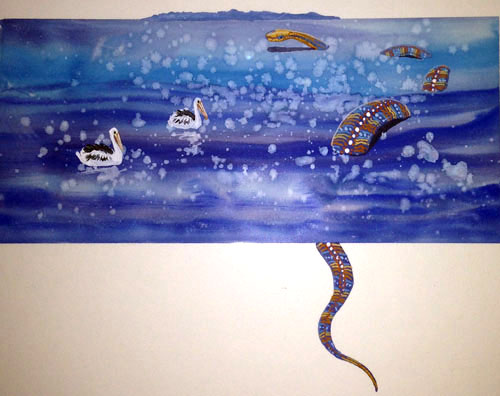Nyitting Yarn - Cosmological or Dreaming Stories
Nyungar Katitjin is people’s knowledge based on cosmological stories from the Dreamtime, known as Nyitting to Nyungar, on which cultural knowledge is founded.
The Nyungar word ‘yarn’ has a similar but deeper meaning to the English word ‘yarn’. In Nyungar, a yarn is not just a story: it suggests an inquiry, sometimes a conversation, that answers the questions – why and how?

Waugal by the late Shane Pickett
 boodjar
boodjar
 derbal nara
derbal nara
 djidi-djidi
djidi-djidi
 katitjin
katitjin
 moort
moort
 nyitting
nyitting
 nyungar
nyungar
 waarkal
waarkal
 whadjuk
whadjuk
Click the sound files to hear the Nyungar words on this page.
Traditional Owner, Trevor Walley shares his thoughts on what the Dreamtime means to him:
I think songs and dance and stories and Dreamtime made us what we are. So Dreamtime is who we are and we must embrace our Dreamtime to understand our future…I don’t have all the answers, but the Dreamtime gives us some understanding of where we are now. Every piece of the boodjar, the earth, is connected to the Dreamtime, so if you go to the bobtail dreaming, you go to the emu dreaming, you go to the frog dreaming, you go to the djidi-djidi, the Willy Wagtail dreaming, every bird and every tree and everything is related to the Dreamtime, and so the Dreamtime comes from the earth, the boodjar, the mother earth...1
Nyitting (or Dreamtime) yarns are cosmological stories about events within and beyond the living memories of the Nyungar people. There are many significant Nyitting stories relating to Derbal Nara or Cockburn Sound.
Nyitting literally means ‘cold time’, and refers to the time of creation. At the centre of Nyungar cosmology is a huge Waarkal (rainbow serpent) that created the land (Boodjar), people (Moort), and knowledge (Katitjin).2
The Waarkal, or Rainbow Serpent, is the pre-eminent creative ancestral spirit. In Whadjuk country, the rivers, wetlands and coastal lakes are the Dreaming tracks (or story lines) made by the Waarkal and are held to be sacred by Whadjuk Nyungar. Throughout the southwest, the waterways are interconnected with the Dreaming tracks of other ancestral spirits who travelled across the country. These ancestral spirits encountered each other and the course of these encounters created the features of the landscape such as hills and even the stars.
One account of the creation of the Nyungar Boodjar by the Waarkal and other creative ancestors is given by storyteller Dr Noel Nannup. Click on the link below to download the story.
Sylvia Hallam points to the rich complex of associations between the Waarkal and the chief physical elements of nature – fire, water, the sky, the earth – saying that, ‘the connection of the serpent with water and also with dark caverns, are themes seen as recurring within and without the South-west of Australia’ (Hallam 1975:82). Descriptions of the Rainbow Serpent have a common core of beliefs about its qualities. It dwells deep within watercourses, waterholes, rivers and rock pools, and maintains the quantity and the quality of the drinking water. If a site closely associated with the Rainbow Serpent is desecrated in any manner – and that includes virtually all places where there is water in significant quantities or, in arid areas, water courses albeit dry for most of the year – the persons responsible are in literal physical danger and the land itself is depleted, for the Rainbow Snake will go away.3
The Waarkal or Rainbow Serpent as a major creative Dreamtime being is widespread in Western Australian and indeed many Aboriginal Australian yarns. In the early account given by Radcliffe-Brown, the Waarkal is seen as aggressive:
Crossing now to Western Australia, I have been able to trace the belief in the rainbow-serpent, living in deep, permanent water-holes, through all the tribes from the extreme south-west at least as far north as the Ninety Mile Beach and eastwards into the desert. In the tribes around Perth it is called wogal, and certain water-holes are pointed out as being each the abode of a wogal. It is regarded as dangerous for anyone except a medicine-man to approach such a water-hole, as the serpent is likely to attack those who venture near its haunts. “It generally attacks females, and the person whom it selects for its victim pines and dies away almost imperceptibly. To this creature’s influence the aborigines attribute all sores and wounds for which they cannot otherwise account. Its supposed shape is that of a huge winged serpent ….A woman who miscarries or has any complaint subsequent to childbirth is said to be Waugalan, or under the influence of the Waugal.” 4





